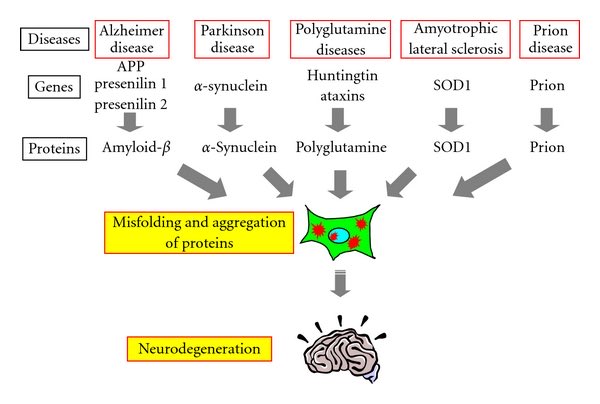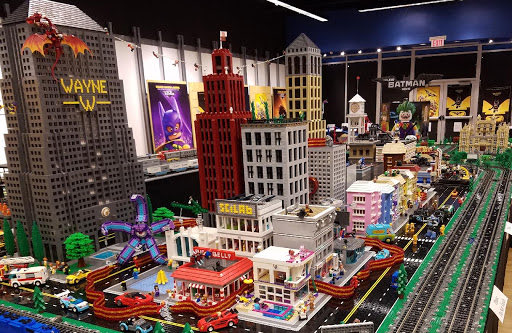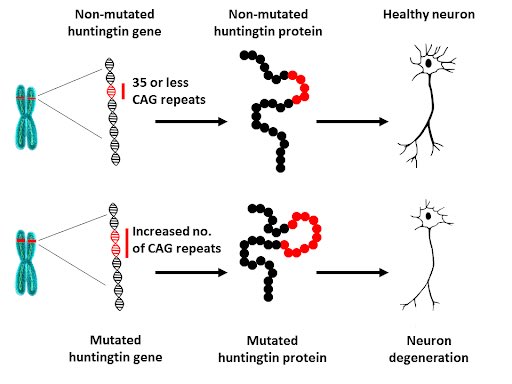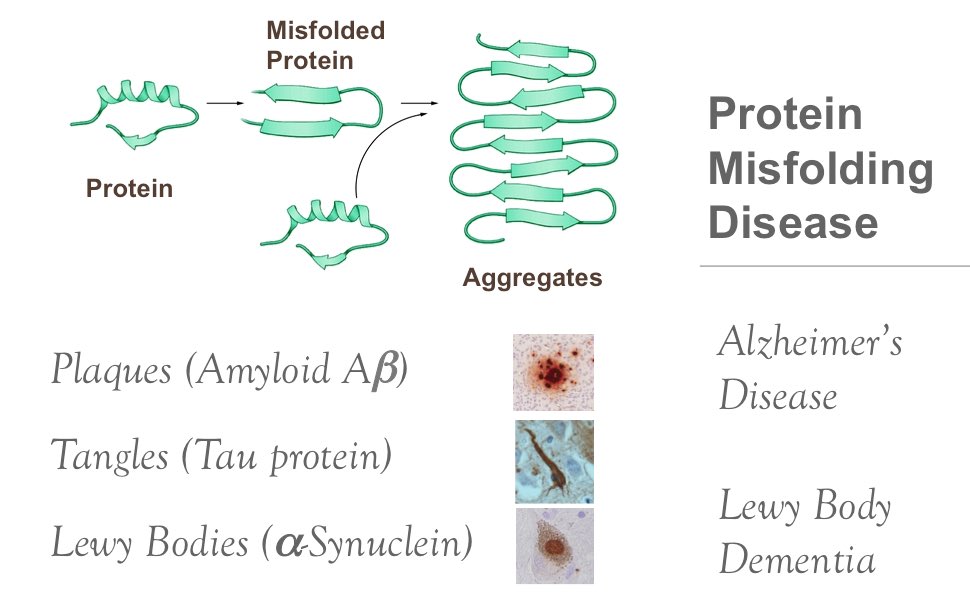Storytime: Over 100 years ago, a physician was treating a patient who could barely remember basic details of their own life. When the patient passed, the doctor examined the patients brain and found plaques and deformities all around the brain. 1/
The physician was Dr. Alzheimer, & the disease he was observing became known as Alzheimer’s disease. For a long time, we thought that becoming senile and losing your memory was simply a part of aging, however, in these cases there was actually physical brain damage occurring. 2/
Alzheimer’s disease is a neurodegenerative disease, which is a big word that describes diseases that cause your neurons to lose their function or die. Neurons are the building blocks of our brain, our entire nervous system. 3/
Tech advancements have improved our understanding beyond what Dr. Alzheimer found over 100 years ago. We now know that a key molecular pathway involved in neurodegenerative diseases is the misfolding, aggregation, & accumulation of proteins in the brain. Let me explain that. 4/
Lego cities. Let’s go with Gotham City. There are so many different types of Legos and they all do different things to help make the Lego city what it is. Imagine you’re trying to build a Lego Batmobile but the wheels are cubes instead of being round. What a crappy Batmobile. 5/
Batmobile with cube wheels? That won’t drive at all and if you get it on the road it will cause a traffic jam. Yikes. Imagine every Lego brick to build Wayne enterprises was diamond shaped instead of rectangular. That’s really hard to stack. The whole building would collapse. 6/
Now imagine Gotham city is our cells, and the Legos are proteins. All the little Lego proteins have a job and they have to be shaped right so that the city doesn’t fall apart, so there are no traffic jams, all of that. How do proteins get their shape? Let me tell you. 7/
They fold like origami. Yes, I’ll rewind a bit. Our DNA  https://abs.twimg.com/emoji/v2/... draggable="false" alt="🧬" title="DNA" aria-label="Emoji: DNA"> has the recipe for the proteins. Our cells are kinda like 3D printers where our DNA has coded information for a protein, and it gets printed out by lil machines called ribosomes. Still reading? Stay with me! 8/
https://abs.twimg.com/emoji/v2/... draggable="false" alt="🧬" title="DNA" aria-label="Emoji: DNA"> has the recipe for the proteins. Our cells are kinda like 3D printers where our DNA has coded information for a protein, and it gets printed out by lil machines called ribosomes. Still reading? Stay with me! 8/
As the protein is “printing” out of the ribosome it starts folding up bc it’s made up of amino acids that either love or hate each other or love or hate WATER  https://abs.twimg.com/emoji/v2/... draggable="false" alt="💦" title="Schweißtropfen" aria-label="Emoji: Schweißtropfen"> etc. We are mostly made up of water so the water hating parts of the proteins like to tuck inside. They are STICKY. 9/
https://abs.twimg.com/emoji/v2/... draggable="false" alt="💦" title="Schweißtropfen" aria-label="Emoji: Schweißtropfen"> etc. We are mostly made up of water so the water hating parts of the proteins like to tuck inside. They are STICKY. 9/
There are also helper proteins called chaperones that grab onto the newborn protein for dear life to make sure it folds right because we DO NOT want it to misfold. We don’t want those problems. At all. (yes proteins are “helping” other proteins fold I know it sounds crazy). 10/
Our body has so many checkpoints to make sure that proteins are folded correctly but sometimes it doesn’t happen the way it should. For example, the neurodegenerative disease Huntington’s Disease. Remember DNA codes for proteins? DNA mutations cause protein mutations. 11/
The biochemistry of Alzheimer& #39;s disease, the most common cause of dementia, is not yet very well understood. It has been identified as a protein misfolding disease due to the accumulation of abnormally folded amyloid beta proteins. We’re still learning about it. 12/
The brains of people with Parkinson’s disease can contain abnormal clumps of proteins called Lewy bodies. These clumps are largely made up of the protein alpha-synuclein, which plays a role in crosstalk between brain cells. Lewy bodies interrupt this talk. 13/
My work as a molecular scientist included creating “mini brains” to test 1000s of potential anti-disease drug compounds using a big robot. I helped develop the worlds 1st successful protocol to commercially manufacture BIG quantities of neurodegenerative proteins 4 research. 14/
There is so much I could share but there is something important to talk about here at the societal level. Visit the Alzheimer’s Association website and read these statistics. 15/ https://www.alz.org/alzheimers-dementia/facts-figures">https://www.alz.org/alzheimer...
Alzheimer’s disease impacts A LOT OF PEOPLE but is not funded as vigorously as other disease research efforts. People with Alzheimer’s, depending on their stage, may not be able to advocate for this research and bring awareness to what they are experiencing! Think about it. 16/
Please, consider supporting some of these less funded diseases. Some of the work I’ve done has been supported by foundations that send your donations to fund the labs. Let’s try to do our part in building awareness to support those who can’t advocate for themselves. 17/
I think we can find a cure for this, my opinion is that the research needs to be more heavily funded and more attention needs to be placed on neurodegenerative diseases for the solution to be found faster. Same for any disease— if the research is prioritized we make progress. 18/
Where does that leave us? According to statistics from the Alzheimer’s Association, Many of us reading this have or will develop a neurodegenerative disease. Or we already are or will potentially become caretakers for someone who does. Become an advocate. http://alz.org"> http://alz.org
I worked really hard on this thread so after you consider donating to research- if you want to wear science on your sleeve and if this thread inspired you to love and support science in another way, check out http://smartypants.store"> http://smartypants.store and shop science fashion!
If you want to learn more about me, you can go to my website! A lot of people have been asking about me teaching, speaking, etc. I& #39;m finishing a doctorate in science education next month, and I do speak for organizations, etc. http://scimaven.com"> http://scimaven.com

 Read on Twitter
Read on Twitter



 etc. We are mostly made up of water so the water hating parts of the proteins like to tuck inside. They are STICKY. 9/" title="As the protein is “printing” out of the ribosome it starts folding up bc it’s made up of amino acids that either love or hate each other or love or hate WATER https://abs.twimg.com/emoji/v2/... draggable="false" alt="💦" title="Schweißtropfen" aria-label="Emoji: Schweißtropfen"> etc. We are mostly made up of water so the water hating parts of the proteins like to tuck inside. They are STICKY. 9/">
etc. We are mostly made up of water so the water hating parts of the proteins like to tuck inside. They are STICKY. 9/" title="As the protein is “printing” out of the ribosome it starts folding up bc it’s made up of amino acids that either love or hate each other or love or hate WATER https://abs.twimg.com/emoji/v2/... draggable="false" alt="💦" title="Schweißtropfen" aria-label="Emoji: Schweißtropfen"> etc. We are mostly made up of water so the water hating parts of the proteins like to tuck inside. They are STICKY. 9/">
 etc. We are mostly made up of water so the water hating parts of the proteins like to tuck inside. They are STICKY. 9/" title="As the protein is “printing” out of the ribosome it starts folding up bc it’s made up of amino acids that either love or hate each other or love or hate WATER https://abs.twimg.com/emoji/v2/... draggable="false" alt="💦" title="Schweißtropfen" aria-label="Emoji: Schweißtropfen"> etc. We are mostly made up of water so the water hating parts of the proteins like to tuck inside. They are STICKY. 9/">
etc. We are mostly made up of water so the water hating parts of the proteins like to tuck inside. They are STICKY. 9/" title="As the protein is “printing” out of the ribosome it starts folding up bc it’s made up of amino acids that either love or hate each other or love or hate WATER https://abs.twimg.com/emoji/v2/... draggable="false" alt="💦" title="Schweißtropfen" aria-label="Emoji: Schweißtropfen"> etc. We are mostly made up of water so the water hating parts of the proteins like to tuck inside. They are STICKY. 9/">





